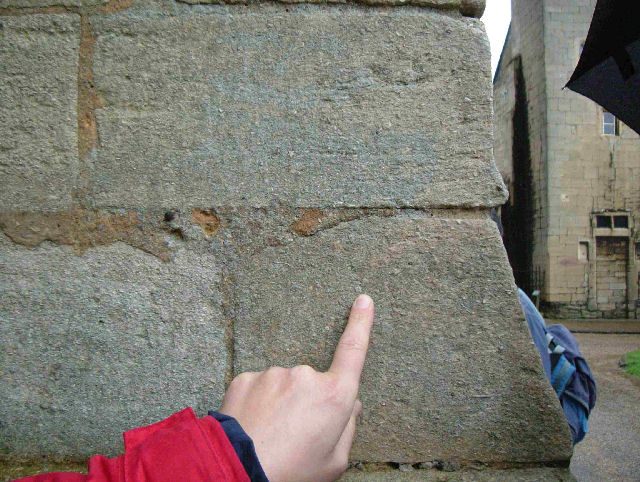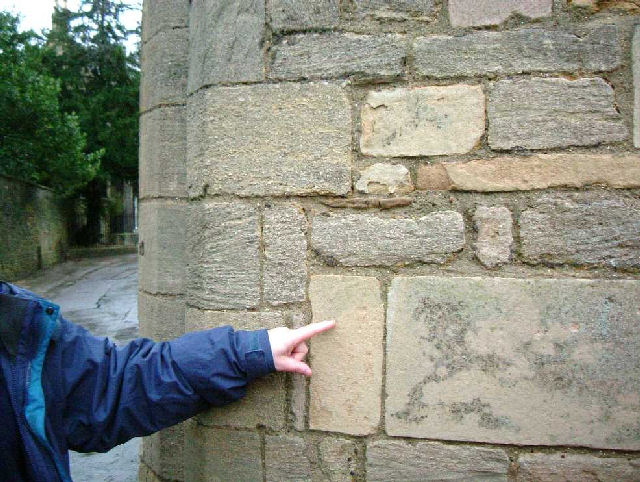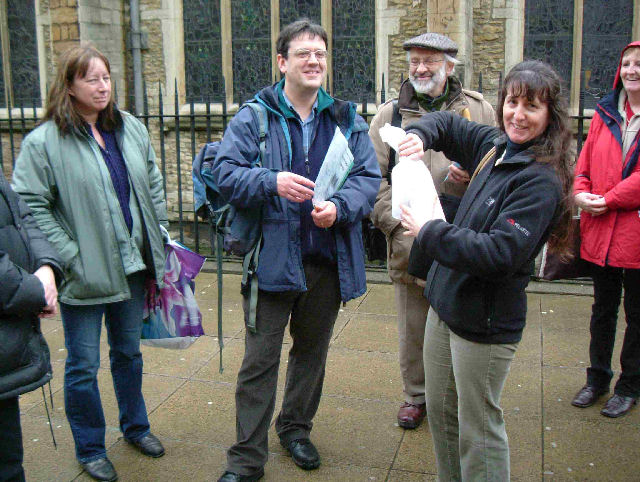|
Date: |
Sunday 12 February 2006 |
|
Location: |
Peterborough |
|
Leader: |
Dr Colin Prosser |
|
Author: |
Ian Clarke |
Peterborough Museum and City Centre Geology Trail
12 of us met on a dull, damp Sunday to explore the geology of Peterborough City Centre. Our starting point was the City Museum, where we visited the museum's geology collection. This put the local geology in context and helped us to understand a little more about the examples of the rocks we would see on the geology trail.
The Peterborough area is located on Jurassic strata. The museum's collection shows the area's geological history from the Jurassic to Recent. There is a good collection of fossils from the Oxford Clay and Jurassic limestone's. The Oxford Clay has been the source of Peterborough's main industry-brick making-for the past 100 years. It is also the source of some impressive fossils - ichthyosaurs, plesiosaurs, and crocodiles, as well as ammonites, belemnites, bivalves, and brachiopods. There was also a good display of Ice Age remains-reindeer, woolly mammoth, bison, and from warmer interludes, hippopotamus. We also visited the opening day of the museum's new archaeology display. No fossils here, but we were accosted by Roman soldiers, Roman citizens clad in togas, a Saxon lady doing some spinning, and a knight in chain mail. Cameras to the fore, hairy legs, knobbly knees and much jollity!
We were then joined by Dr Colin Prosser, Chief Geologist of English Nature, who was our leader for the City Geology Trail. With a daunting 31 possible locations ahead of us, Colin said that the best way of looking at the city's building stones was by their origin - local, national, or international. Our trail included some of Peterborough's remaining old city centre buildings, the Cathedral, and the relatively new Queensgate centre.
Local Stones
We saw many examples of different varieties of the local Jurassic Lincolnshire Limestone. The front of the Museum building has pillars made from a high quality oolitic "freestone" from Ketton and walls made of blocks of Clipsham stone, a shelly limestone. Another local stone is Collyweston Slate. This is not really slate, but a sandy limestone from the lowest beds of the Lower Lincolnshire Limestone. The rock is extracted from mines in the winter and left outside to be split by the frost along the bedding planes. We saw several examples of it being used as roofing material on older buildings.
 |
 |
| Barnack Stone in the Cathedral entrance, a coarse, shelly limestone, with pentacrinus fossil shown. Photo: Don Cameron | Differences in the source of 2 Upper Lincolnshire Limestones: rough, shelly Barnack Rag has been replaced with finer oolitic Ketton Stone in this wall near the Cathedral. Photo: Don Cameron. |
Peterborough Cathedral's main building stone is the Barnack Ragstone, another very shelly limestone. Sharp-eyed members of the party spotted some sparkling crinoid pentangles in the wall at the Cathedral entrance. The other local stone used in the Cathedral is the Alwalton Marble, not marble at all, but a shelly limestone that polishes well, the font is a good example, although it has had some similar Purbeck 'Marble' added at a later date.
Yet another variety of Jurassic limestone was seen at Harriet's Tea Rooms. This was the Wittering Pendle, a creamy, brown limestone with excellent waterproof qualities. The final example of local stone was the extensive use of locally made bricks, both ancient and modern. Some very old bricks were seen in the Cathedral's Great Cloister wall. There was some heated discussion about the quality of repairs to the arches here.
National stones
We saw lots of building stones from elsewhere in the country, brought in as transport improved and the city prospered. These included:
Cross-bedded Triassic sandstone from Staffordshire (Town Hall pillars)
Welsh slate (numerous roofs)
Cornish granite (polished version-M&S side entrance, rough-cut version-HSBC)
Chalk Marl or Clunch (St Tibba's shrine in the Cathedral)
Carboniferous Limestone (tombstones in the Cathedral, one with a lovely piece of coral)
Frosterley Marble from Co. Durham ( Tomb of William Clavelle Ingram)
York Stone (paving slabs and kerbs), Mountsorrel Granite, (kerbs)
Portland Stone (Lloyd's Bank)
One glacial erratic (igneous boulder from the northwest in the Cathedral grounds
International stones
There was a wonderful selection of rocks from overseas to be seen along the trail. These included:
Larvikite from Norway, often used for banks, but was also the hallmark of Burton's tailor's shops (1918-1938).
Serpentinite from the Italian Alps
Carrara Marble from Italy. This is a true marble and there are plenty of examples in the Cathedral as memorial plaques.
Baltic Brown granite from Finland. This polished rock forms the surrounds to the fountains in the Queensgate Shopping Centre, It contains spherical pink feldspar crystals. This is orthoclase feldspar and the crystals are surrounded by a halo of green plagioclase feldspar, a texture known as Rapakivi. This rock is dated at more than 1500 million years old.
Polished Jurassic limestones from Germany and Italy. These form the floor of the Queensgate Shopping Centre, and contain wonderful fossils-ammonites, belemnites, and sponges.
This was a most enjoyable trip, despite the weather. Thank you to Tracy Atkinson for organising and to Dr Colin Prosser for leading with such enthusiasm. Colin encouraged us all to look at our towns and, if there isn't one already, write our own geology trail. You never know what exotic rock you might come across.
 |
 |
| German Limestone from the Jura used as floor tiling in the Queensgate centre contains a number of large ammonite fossils, shown here, as well as belmenites and sponges. Photo: Don Cameron |
Saying 'Thank You' at the end of the trip. Photo: Don Cameron |
Further reading: Peterborough Geology Trail by Alan Dawn of the Stamford and District Geological Society. £1.50 from Peterborough City Museum and Art Gallery, Priestgate, Peterborough. They've had a run on them recently.